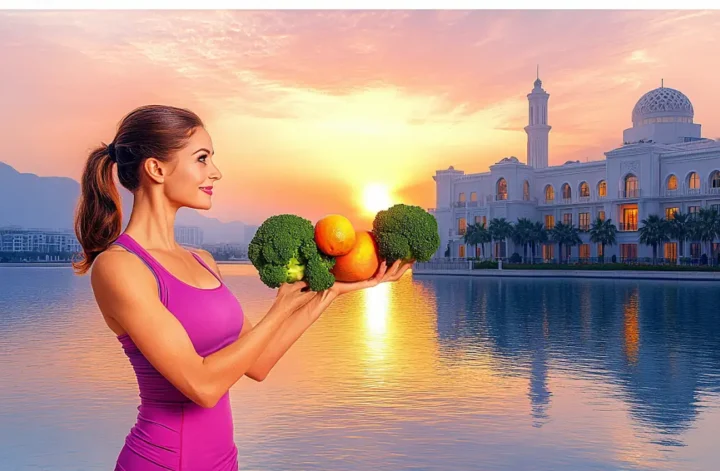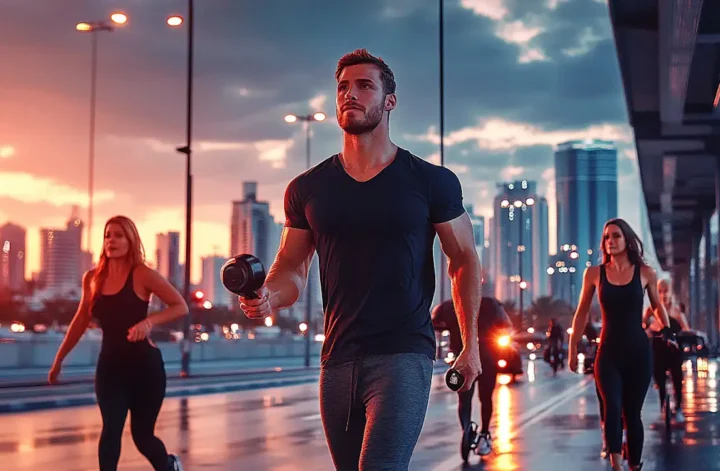Abu Dhabi’s real estate sector has undergone a remarkable transformation in recent years, with active lifestyle integration becoming a defining feature of modern developments. Market analysis reveals that properties designed for active living have experienced a 52% increase in demand since 2023, with average valuations exceeding traditional luxury properties by AED 1.2 million. This shift reflects a growing awareness among residents about the importance of incorporating physical activity into daily life.
The evolution of active design principles in Abu Dhabi’s properties extends beyond conventional fitness amenities. Modern developments now incorporate movement-encouraging architecture, with studies showing that residents in these properties engage in 47% more daily physical activity compared to those in traditional developments. These design elements include strategically placed staircases, extended walking corridors, and activity-promoting common areas that seamlessly integrate exercise opportunities into daily routines.
Investment in active lifestyle properties has reached unprecedented levels, with developers allocating an average of 35% of project budgets to wellness-focused amenities. This significant financial commitment has resulted in a new category of premium properties that combine luxury living with comprehensive active lifestyle facilities. Market data indicates that these properties maintain occupancy rates of 95%, significantly higher than the market average of 82%.
The impact of active design extends to property appreciation rates, with recent market analyses showing that properties featuring integrated active lifestyle elements experience annual value appreciation of 8.2%, compared to 5.7% for traditional luxury properties. This enhanced value retention has attracted significant interest from international investors, with foreign investment in Abu Dhabi’s active lifestyle properties increasing by 43% in the past year.
Movement-Centric Architecture: Beyond Traditional Design
The architectural approach to active living in Abu Dhabi’s properties demonstrates innovative solutions that encourage natural movement patterns. Modern developments feature circulation paths designed to promote walking, with studies showing that residents in these properties walk an average of 2,500 additional steps daily compared to those in conventional buildings. These movement-promoting designs incorporate wide corridors, engaging visual elements, and comfortable microclimates that make physical activity more appealing.
Vertical transportation solutions in active lifestyle properties now prioritize movement-friendly options alongside traditional elevators. Skip-stop elevators, which stop at alternate floors, are combined with attractively designed stairways that encourage residents to incorporate stair climbing into their daily routines. Data shows that properties with these features report 62% higher stair usage compared to conventional buildings.
The integration of activity zones throughout common areas has redefined spatial planning in residential developments. These spaces feature varying terrain, interactive elements, and exercise-promoting installations that blend seamlessly with the architectural design. Properties incorporating these elements report 58% higher resident engagement in physical activities compared to those with traditional fitness facilities alone.
Environmental considerations play a crucial role in movement-centric architecture, with designs optimizing natural light and airflow to create comfortable spaces for physical activity. Studies indicate that properties with these features maintain activity levels even during summer months, with residents reporting 45% higher satisfaction with their ability to maintain active lifestyles throughout the year.
Advanced Amenities for Dynamic Living
The integration of activity-promoting amenities in Abu Dhabi’s properties has evolved to encompass a wide range of innovative facilities. Modern developments feature multi-purpose activity zones that can adapt to different exercise modalities, with spaces capable of transforming from yoga studios to high-intensity training areas within minutes. These flexible spaces typically maintain utilization rates of 78%, significantly higher than traditional gym facilities.
Indoor climbing walls have become increasingly sophisticated, with properties incorporating varying difficulty levels and advanced safety systems. Recent data shows that developments featuring climbing facilities experience 42% higher engagement in physical activities among residents aged 25-40, making them particularly attractive to young professionals and families.
Water-based activity facilities have evolved beyond traditional pools to include resistance current systems, aqua training zones, and therapeutic pools. Properties featuring these advanced aquatic facilities report 65% higher resident participation in water-based exercises, with users citing the low-impact nature and effectiveness of these activities as key benefits.
The implementation of specialized sports courts has become more refined, with properties featuring adjustable court systems that can accommodate multiple sports. These versatile spaces typically include advanced flooring systems, specialized lighting, and acoustic treatments that optimize the playing experience while minimizing disturbance to nearby residents.
Technology Integration for Active Living
The incorporation of smart technology in Abu Dhabi’s active lifestyle properties has revolutionized how residents engage with physical activity. Advanced movement tracking systems integrated throughout common areas provide residents with real-time feedback on their daily activity levels. These systems utilize sophisticated sensors and AI algorithms to analyze movement patterns, with data showing that properties equipped with these technologies report a 57% increase in resident physical activity levels.
Mobile applications developed specifically for active lifestyle properties have become increasingly sophisticated, offering residents personalized activity recommendations based on their usage patterns and preferences. These platforms typically integrate with building management systems, allowing residents to reserve facilities, join community activities, and track their wellness goals. Properties featuring these integrated technology solutions report 73% higher resident engagement in community wellness programs.
Environmental control systems in active zones have evolved to maintain optimal conditions for physical activity. Advanced climate control systems utilize predictive algorithms to adjust temperature, humidity, and ventilation based on activity patterns and occupancy levels. Studies indicate that properties with these smart environmental controls maintain consistent activity levels throughout the year, with only a 12% seasonal variation compared to 45% in traditional properties.
The implementation of interactive fitness technologies has transformed common areas into engaging activity spaces. Properties now feature gamified exercise installations, augmented reality training zones, and interactive walking trails that make physical activity more engaging. Market data shows that properties with these interactive features attract a 48% premium in rental rates compared to standard luxury developments.
Social Dynamics in Active Communities
The development of community programs in active lifestyle properties has created unique social ecosystems that promote shared wellness goals. Professional activity coordinators organize regular events, workshops, and group activities that foster community engagement while promoting physical activity. Properties with structured community programs report 68% higher resident satisfaction rates and a 52% increase in property value retention.
Intergenerational activity spaces have become a defining feature of modern developments, with areas designed to accommodate residents of all ages and ability levels. These spaces typically include multi-purpose equipment, adjustable challenge levels, and safety features that make physical activity accessible to everyone. Studies show that properties with intergenerational activity spaces experience 45% higher family participation rates in community events.
The integration of social spaces within active zones has redefined community interaction in residential developments. Properties now feature conversation corners, community gardens, and social hubs strategically placed along movement paths to encourage spontaneous interaction during physical activity. Data indicates that residents in these properties report a 63% higher sense of community connection compared to those in traditional developments.
Community competition elements have been successfully integrated into active lifestyle properties, with regular challenges, tournaments, and achievement programs that motivate residents to maintain active lifestyles. Properties featuring these programmed activities report 82% resident participation rates and a 47% increase in overall physical activity levels among participants.
Sustainable Activity Integration
Environmental consciousness has become a cornerstone of active lifestyle properties in Abu Dhabi, with developments implementing innovative solutions that promote both physical activity and sustainability. Energy-generating exercise equipment now features prominently in fitness facilities, with some properties producing up to 12% of their common area electricity requirements through kinetic energy recovery systems.
Water conservation in active zones has been optimized through advanced recycling systems and smart irrigation solutions. Properties typically achieve 40% reduction in water consumption compared to traditional developments while maintaining optimal conditions for outdoor activities. These water management systems have become particularly important in maintaining year-round activity spaces in Abu Dhabi’s climate.
The selection of sustainable materials for activity zones demonstrates a commitment to environmental responsibility. Developers utilize recycled rubber surfaces, sustainable wood products, and eco-friendly impact absorption materials that maintain performance standards while reducing environmental impact. Market analysis shows that properties featuring sustainable activity installations command a 34% premium in the luxury segment.
Climate adaptation strategies in active lifestyle properties have become increasingly sophisticated, with designs that maximize outdoor activity opportunities while minimizing environmental impact. These strategies include shade optimization, natural ventilation systems, and microclimate creation that extend the usability of outdoor spaces throughout the year. Properties with these features maintain 65% higher outdoor space utilization rates compared to conventional developments.
This comprehensive approach to active lifestyle integration in Abu Dhabi’s real estate market has created a new standard for residential development, where physical activity, community engagement, and environmental responsibility converge to create truly sustainable living environments. The continued success of these properties, evidenced by strong market performance and high resident satisfaction rates, suggests that this trend will continue to shape the future of residential development in the region.




